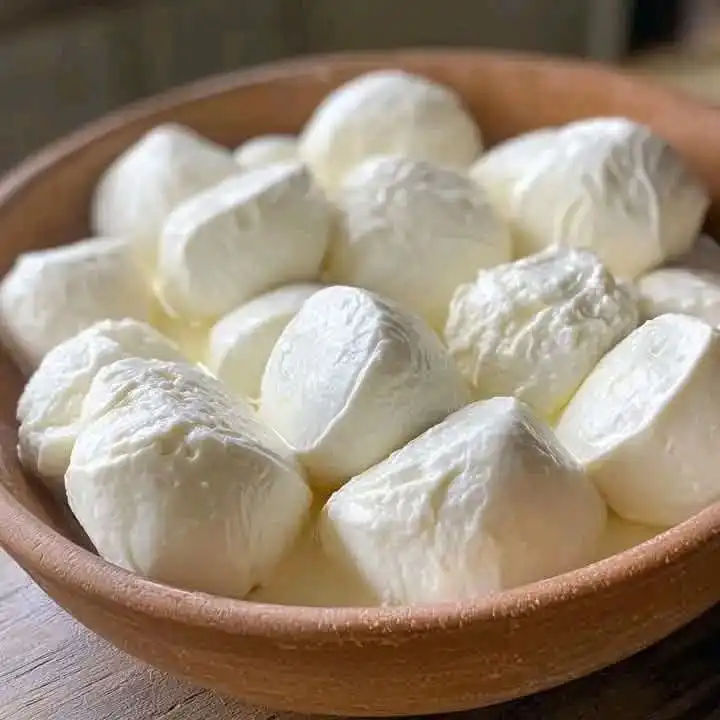Introduction
Homemade mozzarella cheese is one of the most satisfying cheeses you can make in your kitchen. With just a few ingredients and some patience, you can enjoy fresh, stretchy, and creamy mozzarella that tastes far superior to store-bought versions. This cheese is perfect for pizzas, caprese salads, sandwiches, or simply enjoying with a drizzle of olive oil and a sprinkle of sea salt.
Mozzarella is traditionally an Italian cheese made from buffalo milk, but cow’s milk is commonly used for homemade versions. The process of making mozzarella involves curdling the milk with rennet, separating the curds and whey, and then stretching the curds to create that distinct stretchy texture.
This recipe provides a detailed, step-by-step guide to making homemade mozzarella cheese with maximum detail to ensure success. Whether you are a beginner or an experienced home cheesemaker, you’ll find this recipe rewarding and delicious.
Ingredients:
- 1 gallon (3.8 liters) whole milk (preferably non-ultra-pasteurized)
- 1 ½ teaspoons citric acid
- ½ tablet (or ¼ teaspoon) liquid rennet
- 1 teaspoon salt (for flavor)
- 1 cup non-chlorinated water (split into two ½-cup portions)
- Ice water bath (for cooling)
- Optional: Calcium chloride (only if using store-bought pasteurized milk)
Preparation:
Step 1: Prepare the Milk
- Pour the milk into a large stainless steel pot.
- In a small bowl, dissolve the citric acid in ½ cup of non-chlorinated water. Stir well until completely dissolved.
- Pour the citric acid solution into the milk and stir gently to combine.
Step 2: Heat the Milk
- Slowly heat the milk over medium-low heat to 90°F (32°C), stirring occasionally to prevent scorching.
- Once the milk reaches 90°F (32°C), remove it from the heat.
Step 3: Add Rennet and Let the Milk Curdle
- Dissolve the rennet in the remaining ½ cup of non-chlorinated water.
- Gently stir the rennet solution into the warm milk using an up-and-down motion for about 30 seconds.
- Cover the pot and let it sit undisturbed for 5-10 minutes, allowing the milk to coagulate into curds. The curds should have a custard-like consistency and pull away from the sides of the pot.
Step 4: Cut the Curds
- Using a long knife, cut the curds into a checkerboard pattern, making 1-inch cubes.
- Let the curds rest for 5 minutes to release more whey.
Step 5: Cook the Curds
- Return the pot to low heat and slowly heat the curds to 105°F (40°C) while stirring gently.
- Remove the pot from the heat and let the curds sit for 5 minutes.
Step 6: Separate the Whey
- Using a slotted spoon, transfer the curds into a microwave-safe bowl, draining off as much whey as possible.
- Lightly press the curds to remove additional whey.
Step 7: Heat and Stretch the Curds
- Microwave the curds for 30 seconds on high. Drain any additional whey.
- Microwave for another 30 seconds, then knead the curds gently with a spoon or your hands (wear gloves, as it will be hot).
- Repeat this heating and kneading process until the cheese reaches 135°F (57°C) and becomes stretchy.
- Stretch the cheese like taffy until it becomes smooth and shiny.
Step 8: Shape and Cool the Mozzarella
- Shape the mozzarella into a smooth ball or small bocconcini.
- Submerge the cheese in an ice water bath for 5 minutes to set its texture.
- Sprinkle with salt or knead salt into the cheese for enhanced flavor.
Variation
- Smoked Mozzarella: Place the cheese in a smoker for a mild smoky flavor.
- Herbed Mozzarella: Mix fresh basil, oregano, or rosemary into the curds before stretching.
- Marinated Mozzarella: Store in olive oil with garlic and chili flakes for added flavor.
- Low-Sodium Version: Reduce or eliminate salt for a healthier alternative.
- Buffalo Mozzarella: Use buffalo milk instead of cow’s milk for an authentic Italian taste.
Cooking Note
- Use non-ultra-pasteurized milk as ultra-pasteurization can prevent proper curd formation.
- If the curds are too soft, increase the citric acid slightly.
- If the cheese is too dry, reduce the kneading time.
- Handle the curds gently to maintain their structure for a smoother texture.
- If you prefer firmer mozzarella, let the cheese sit in salted whey for a few hours before serving.
Serving Suggestions
- Slice and layer with tomatoes and basil for a Caprese Salad.
- Melt on homemade pizza or pasta dishes.
- Serve with crackers and prosciutto on a charcuterie board.
- Stuff into homemade ravioli or lasagna.
- Pair with fresh fruit like peaches or figs for a sweet-savory balance.
Tips
- Always use a thermometer to maintain precise temperatures.
- Use filtered or distilled water for rennet and citric acid to avoid unwanted reactions.
- Fresh mozzarella is best eaten within 24 hours, but it can be stored in whey or lightly salted water for up to 5 days.
- Freeze mozzarella only if necessary—fresh mozzarella has the best texture when used immediately.
- Experiment with different milks (goat, sheep, or raw milk) for unique flavors.
Prep Time: 15 minutes
Cooking Time: 30 minutes
Total Time: 45 minutes
Nutritional Information (Per 1 oz Serving)
- Calories: 85
- Protein: 6g
- Sodium: 200mg
FAQs
1. Can I make mozzarella without rennet?
Yes! You can use lemon juice or vinegar as a substitute, but the texture may be softer than traditional mozzarella.
2. Why is my mozzarella rubbery?
Over-kneading or overheating the curds can make the mozzarella too firm. Try kneading less and maintaining a lower temperature.
3. Can I use raw milk for this recipe?
Yes! Raw milk creates a richer, creamier mozzarella, but ensure it’s from a trusted source to avoid contamination.
4. How do I store homemade mozzarella?
Store in an airtight container submerged in whey or lightly salted water for up to 5 days. Avoid freezing for best texture.
5. Can I use skim milk?
Full-fat milk is best for mozzarella. Skim milk will produce a drier, less flavorful cheese.
6. How do I add flavor to my mozzarella?
You can mix in herbs, spices, or even smoked paprika for a unique twist.
7. What can I do with leftover whey?
Use it in baking, smoothies, soups, or as a base for fermented foods.
8. Can I make mozzarella without a microwave?
Yes! You can heat the curds in hot whey (170°F/77°C) instead of microwaving.
Conclusion
Making homemade mozzarella cheese is an exciting and rewarding process that results in a fresh, creamy, and versatile cheese. With a handful of ingredients and some practice, you can create delicious mozzarella to enjoy in countless ways. Whether you use it for pizza, salads, or just eat it fresh, the effort is worth it. Follow the steps closely, experiment with variations, and most importantly—enjoy the process!

